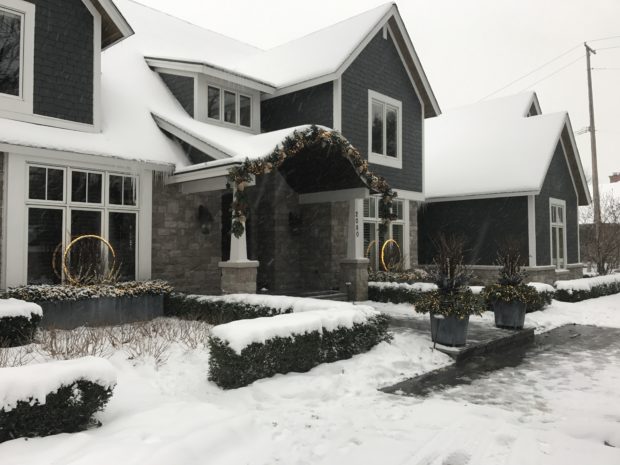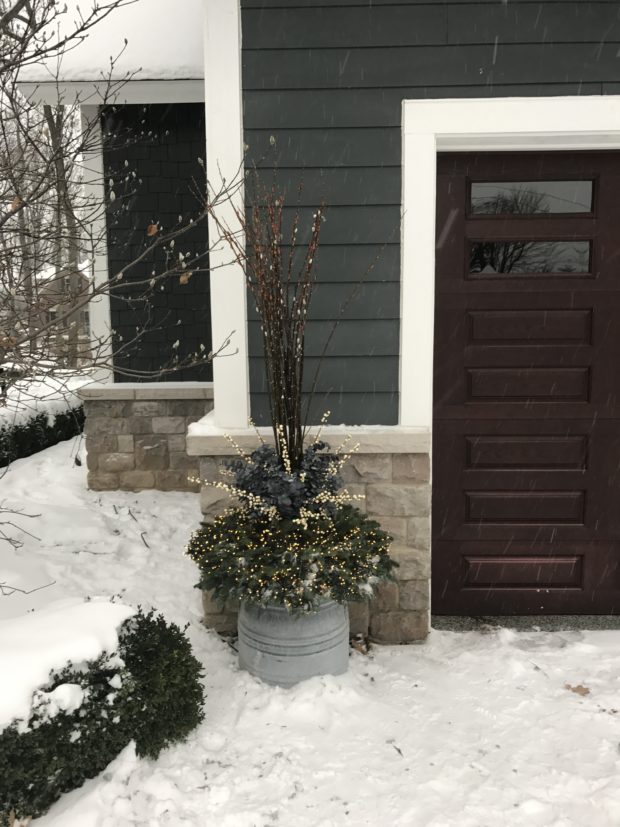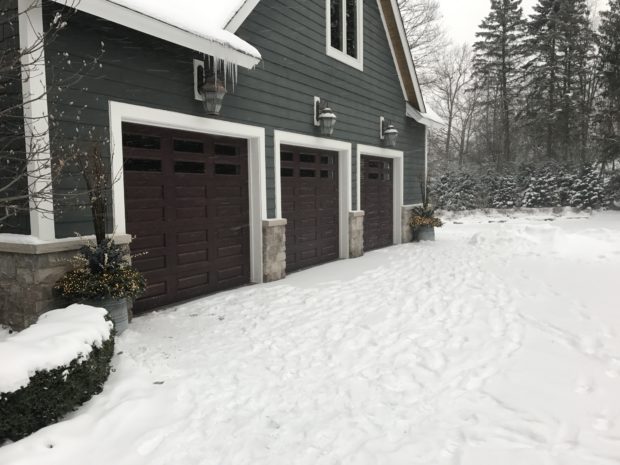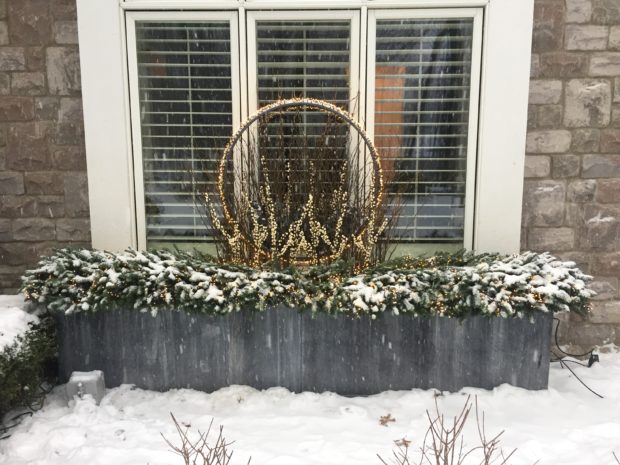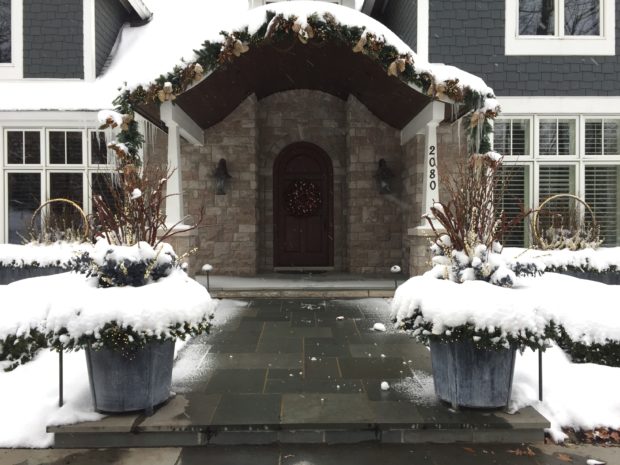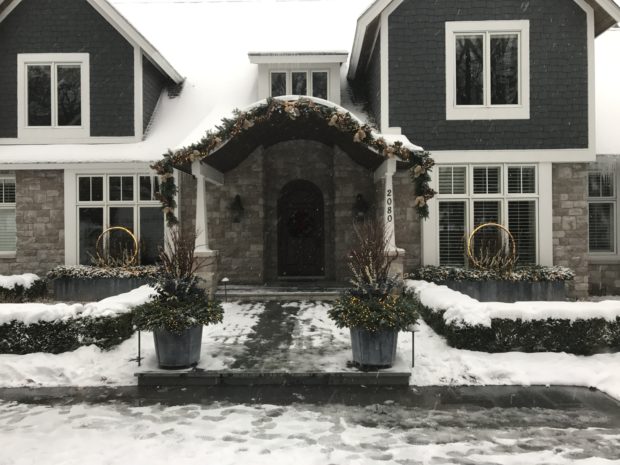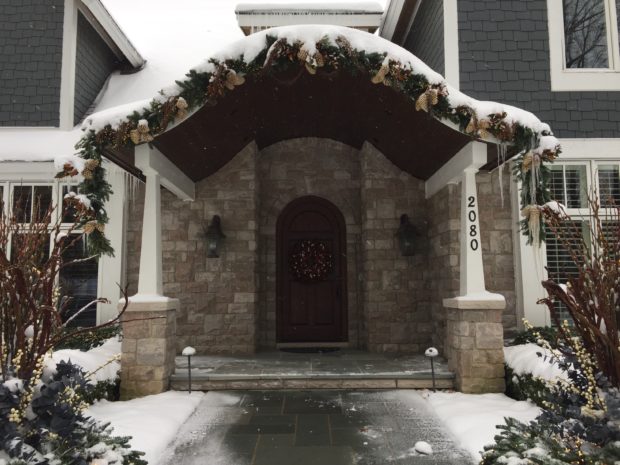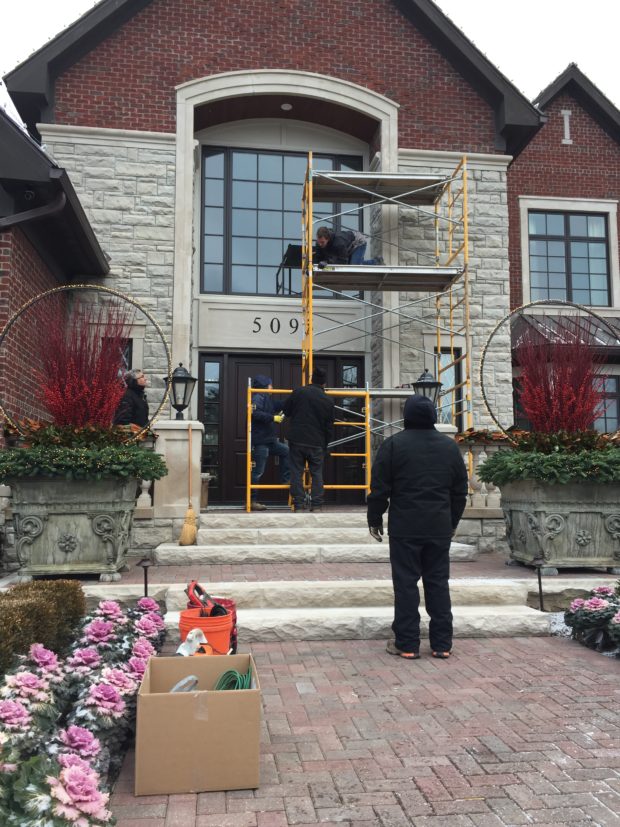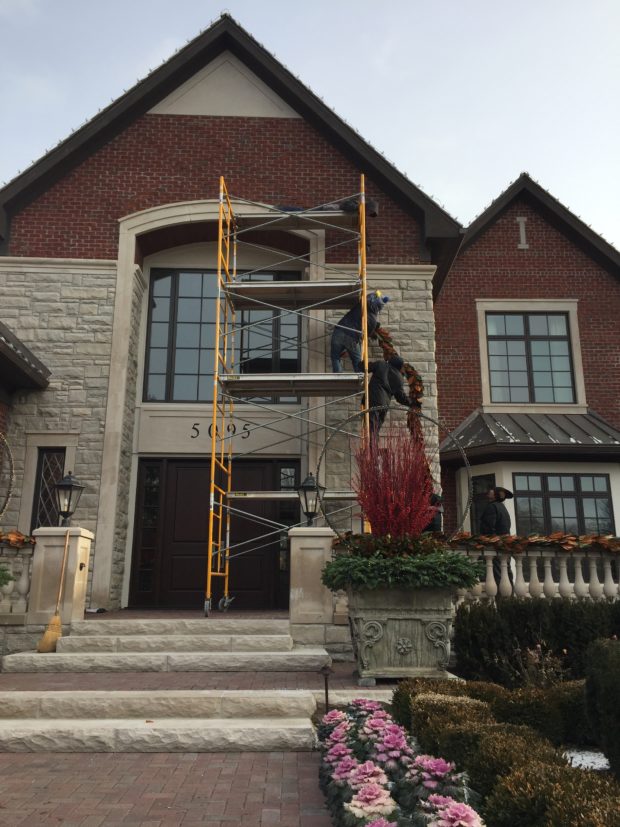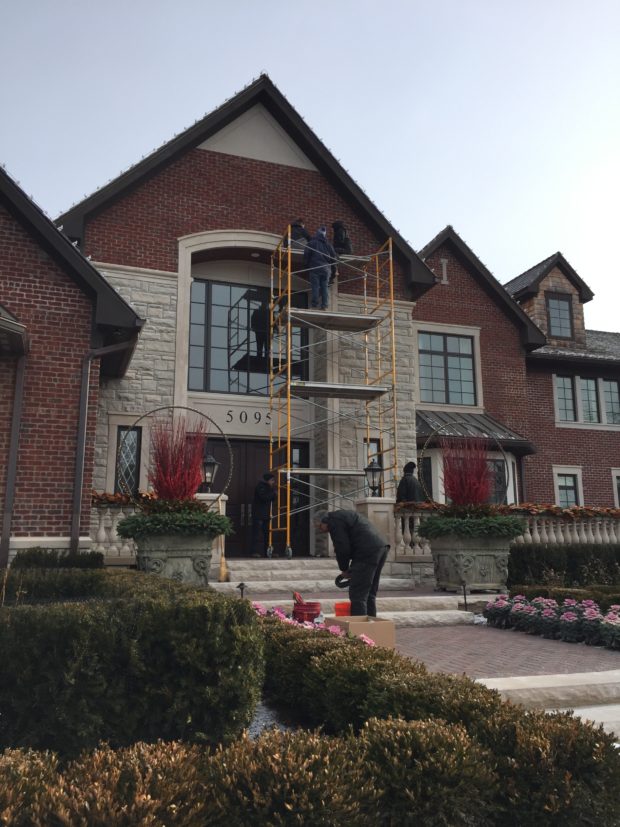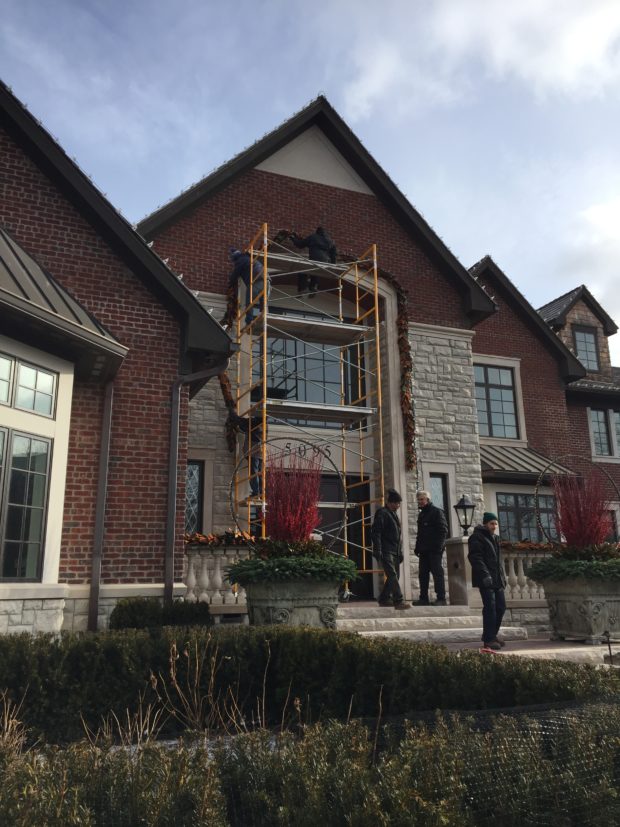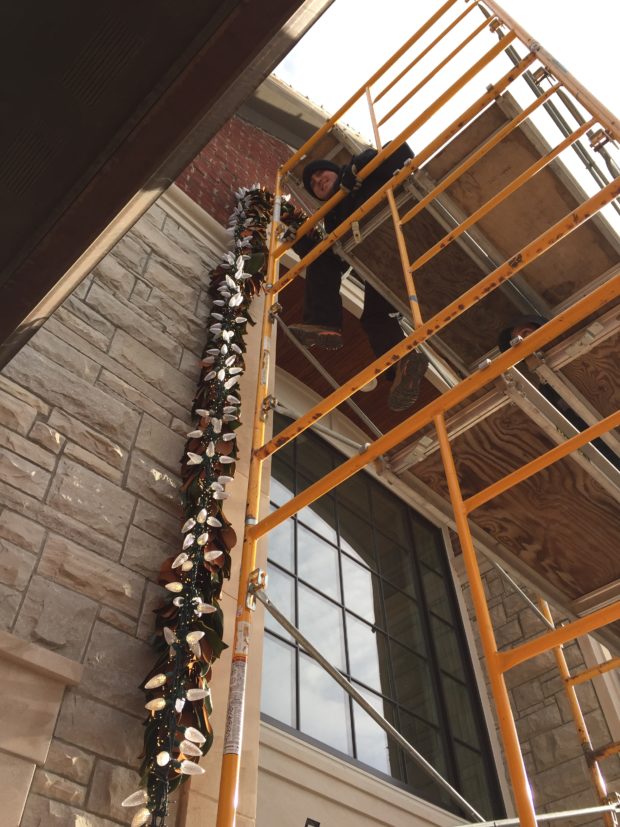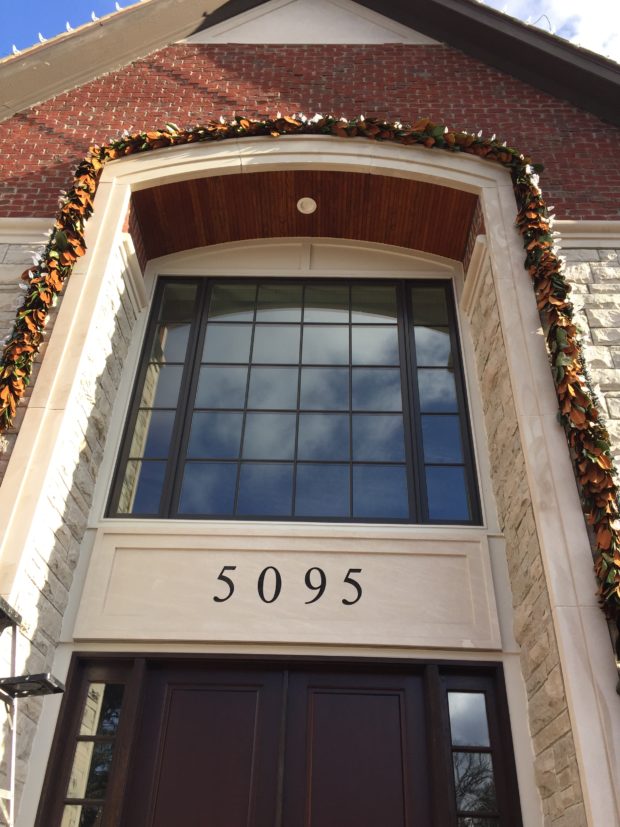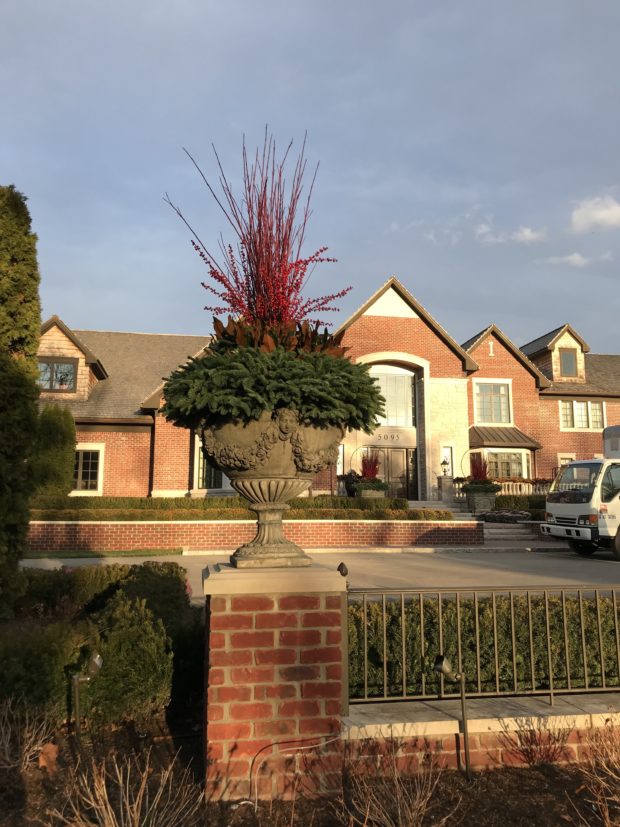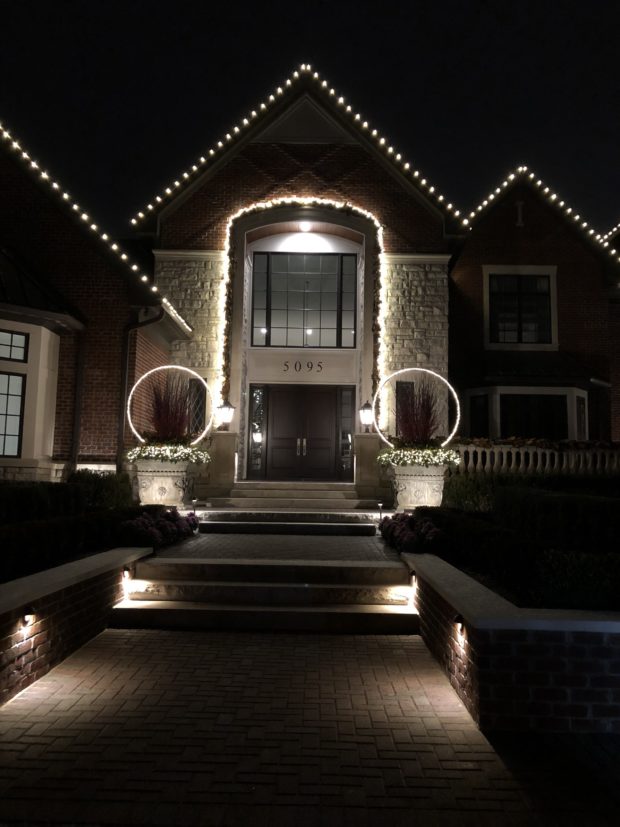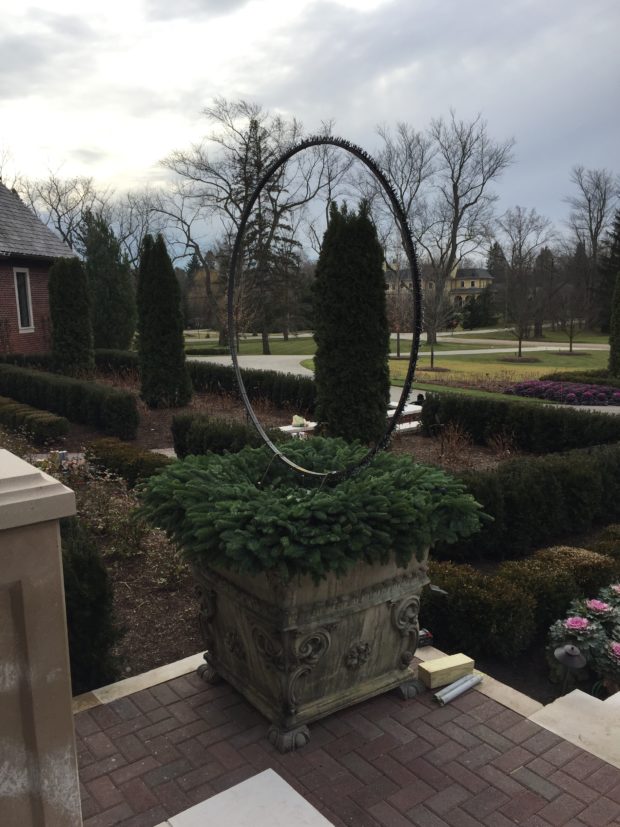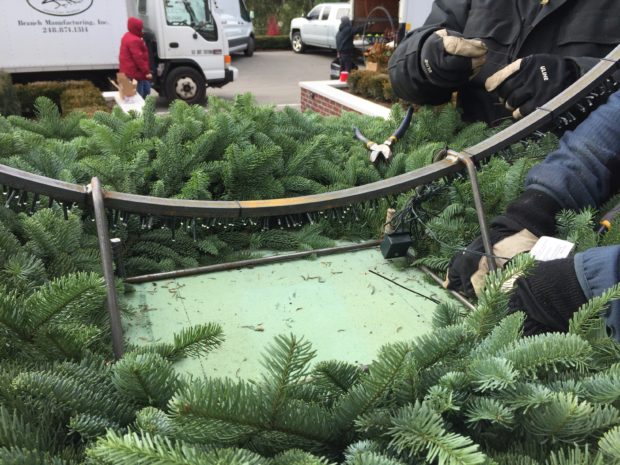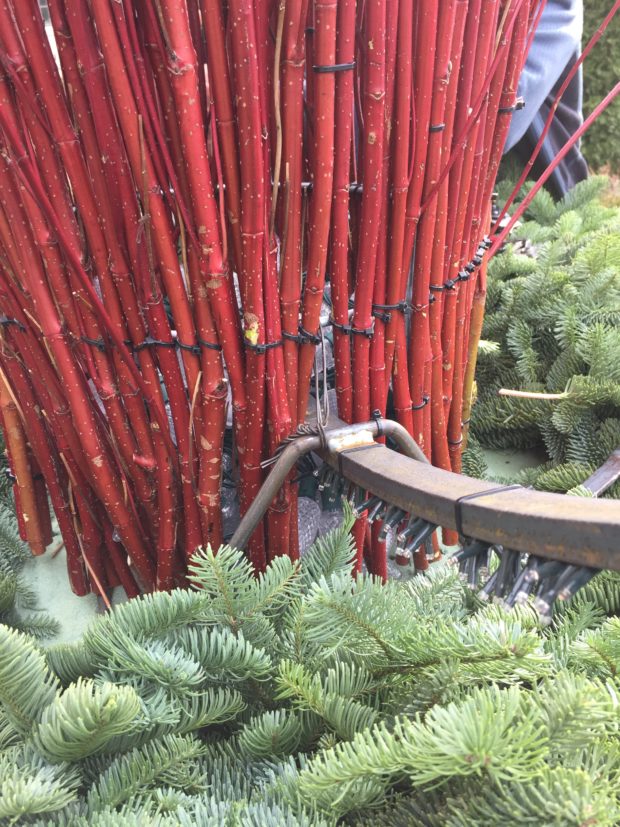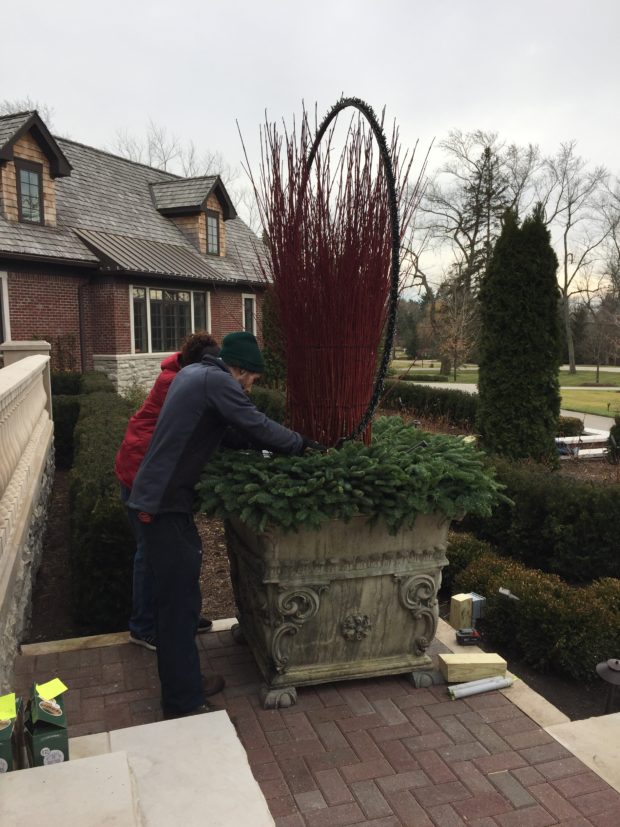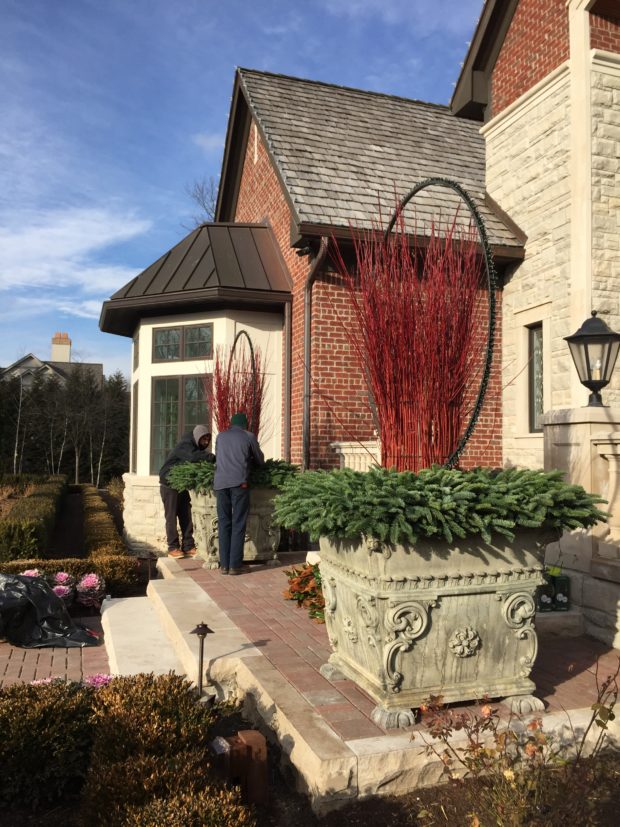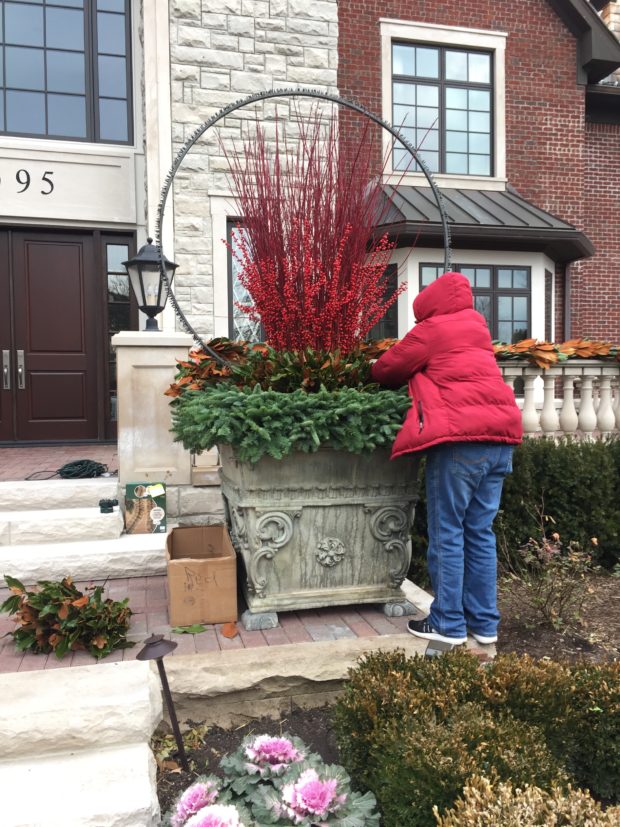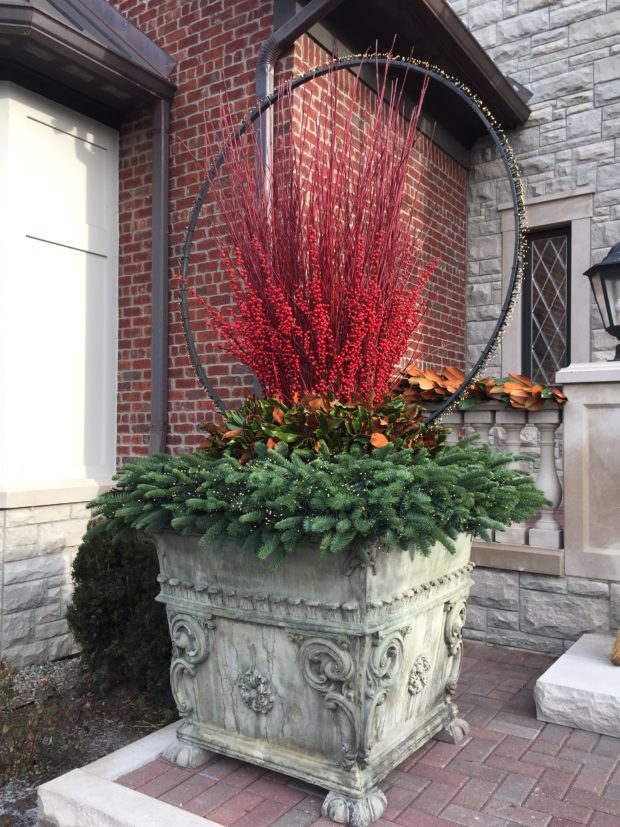 The work run up to Christmas this year had its ups and downs. We were fortunate to have a good many great winter and holiday container and decorating projects. That every one gets done one thoughtful stick at a time means each project takes whatever time it takes. Though we were at it 6 days a week for better than 6 weeks, it became clear we would not finish all of the work before the holiday. The clients whose work will be done next week are not concerned, for a variety of reasons. They were fine that the finish would be later than usual. I was not so easy accepting that state of affairs. I like to finish what I start, on time. What I would have wanted was not to be. The best laid plans do not always work out, do they? I was not so happy that we would be late. One morning last week Dan insisted that he and his crew would be installing a lighted Christmas tree in my side garden. He knew before I did there would no time left over for me to do anything else at home.
The work run up to Christmas this year had its ups and downs. We were fortunate to have a good many great winter and holiday container and decorating projects. That every one gets done one thoughtful stick at a time means each project takes whatever time it takes. Though we were at it 6 days a week for better than 6 weeks, it became clear we would not finish all of the work before the holiday. The clients whose work will be done next week are not concerned, for a variety of reasons. They were fine that the finish would be later than usual. I was not so easy accepting that state of affairs. I like to finish what I start, on time. What I would have wanted was not to be. The best laid plans do not always work out, do they? I was not so happy that we would be late. One morning last week Dan insisted that he and his crew would be installing a lighted Christmas tree in my side garden. He knew before I did there would no time left over for me to do anything else at home.
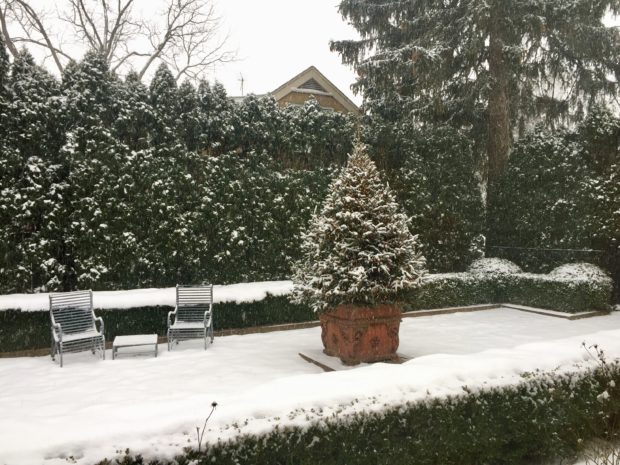 He waved off my protest. I am grateful to him for that. I can see this tree out of all 3 rooms on the south side of my house. Prior to this, I should say it is very unusual for Christmas Eve to arrive on a Sunday, and Christmas on a Monday. We had enough work done at the close of the day on Friday the 22nd that I sent my crews home for the holidays. Three days off would be good for all of them. They have worked their hearts out-I can speak to that. The shop would be closed Christmas Eve, meaning I would be home both Sunday and Monday. The snow started about 1pm on the 24th, and did not stop. It was quiet and steady, and then heavy and steady. The Christmas tree inside was decorated, and my presents wrapped and ready. Those ensuing hours were mine, to watch that snow coming down. The weather was not extraordinary, dramatic or visually demanding. The skies were not booming. Those skies were that pale gray that hinted of a lot of snow in the air. It was a quiet and tranquil affair. Over the course of the day, the landscape became draped in white. I was able to watch that unusual Christmas Eve transformation in peace and quiet.
He waved off my protest. I am grateful to him for that. I can see this tree out of all 3 rooms on the south side of my house. Prior to this, I should say it is very unusual for Christmas Eve to arrive on a Sunday, and Christmas on a Monday. We had enough work done at the close of the day on Friday the 22nd that I sent my crews home for the holidays. Three days off would be good for all of them. They have worked their hearts out-I can speak to that. The shop would be closed Christmas Eve, meaning I would be home both Sunday and Monday. The snow started about 1pm on the 24th, and did not stop. It was quiet and steady, and then heavy and steady. The Christmas tree inside was decorated, and my presents wrapped and ready. Those ensuing hours were mine, to watch that snow coming down. The weather was not extraordinary, dramatic or visually demanding. The skies were not booming. Those skies were that pale gray that hinted of a lot of snow in the air. It was a quiet and tranquil affair. Over the course of the day, the landscape became draped in white. I was able to watch that unusual Christmas Eve transformation in peace and quiet.
 I decided I wanted to take a picture of that tree in the side yard. That would give me a chance to try out a new knee length winter coat, and new snow boots. Of course, Milo wanted to come along. Howard prefers his cozy bed, so we left him behind. I was enchanted when I reached the stairs going to the side yard. It is very hard to give up the gardening season, and that big pot that is always full of flowers all summer long. As I only replanted roses on the south side 2 years ago, that single pot, a surrounding formal arrangement of boxwood, and a pair of chairs is all that draws me to that upper level in the summer. Once those flowers in that large pot fade, and it is too cold to sit in the garden, I shudder for what is to come. I am sure the reason that I have spent better than 10 years keen to learn how to create container arrangements for the winter is a reaction to that loss. It was my landscape super Dan who banished any feeling of loss. That tree, in that pot, in the falling snow, was as beautiful a moment as I have ever had in my garden.
I decided I wanted to take a picture of that tree in the side yard. That would give me a chance to try out a new knee length winter coat, and new snow boots. Of course, Milo wanted to come along. Howard prefers his cozy bed, so we left him behind. I was enchanted when I reached the stairs going to the side yard. It is very hard to give up the gardening season, and that big pot that is always full of flowers all summer long. As I only replanted roses on the south side 2 years ago, that single pot, a surrounding formal arrangement of boxwood, and a pair of chairs is all that draws me to that upper level in the summer. Once those flowers in that large pot fade, and it is too cold to sit in the garden, I shudder for what is to come. I am sure the reason that I have spent better than 10 years keen to learn how to create container arrangements for the winter is a reaction to that loss. It was my landscape super Dan who banished any feeling of loss. That tree, in that pot, in the falling snow, was as beautiful a moment as I have ever had in my garden.
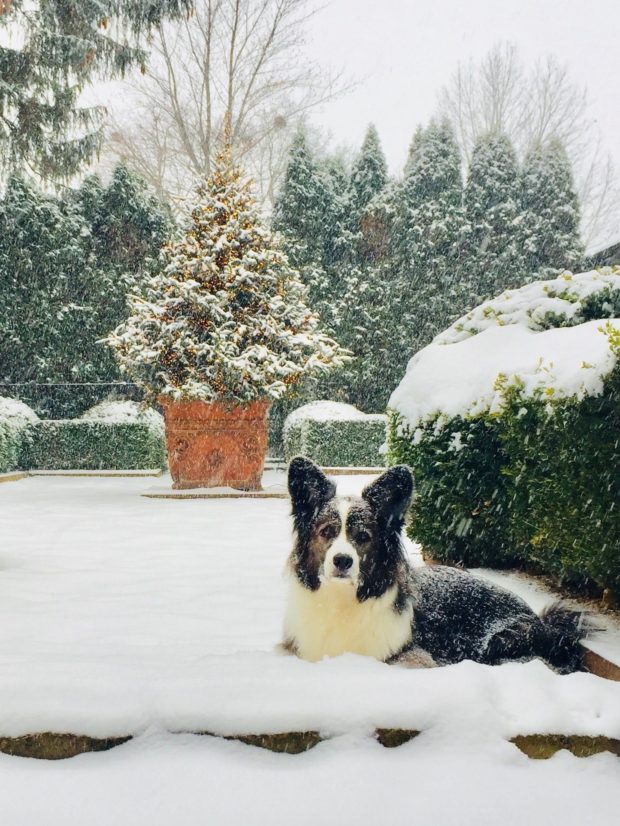 I took a lot of pictures to start. Milo was the steadfast companion that he always is. He picked a spot, and settled in. I settled in, too. I was warm and dry, so why not wait to see what would develop when the late day light would start changing? We both had coats, boots and gloves. We stayed.
I took a lot of pictures to start. Milo was the steadfast companion that he always is. He picked a spot, and settled in. I settled in, too. I was warm and dry, so why not wait to see what would develop when the late day light would start changing? We both had coats, boots and gloves. We stayed.
 By this time I had completely forgotten about that winter work that was yet to be done. I was home for Christmas – much to our mutual satsfaction.
By this time I had completely forgotten about that winter work that was yet to be done. I was home for Christmas – much to our mutual satsfaction.
 It was at this moment that I remembered why I became a gardener. The natural world is a world to which I belong. Sometimes I need to be reminded of this. I remembered my membership today. This Christmas Eve day long snow was a great gift from nature. The gifts from nature are legion, aren’t they? That steady snow brushed away all of my concern about the work yet to be done. I was home in my garden. What could be better?
It was at this moment that I remembered why I became a gardener. The natural world is a world to which I belong. Sometimes I need to be reminded of this. I remembered my membership today. This Christmas Eve day long snow was a great gift from nature. The gifts from nature are legion, aren’t they? That steady snow brushed away all of my concern about the work yet to be done. I was home in my garden. What could be better?
 There are those gardening moments that are perfect moments. This was one of those moments.
There are those gardening moments that are perfect moments. This was one of those moments.
 Buck’s son Stryker could not imagine why I had been outdoors so long in a snow storm. He took this picture of me. The out of doors is a place for me to live, breathe and be, oh yes. I am happy for this picture that says so.
Buck’s son Stryker could not imagine why I had been outdoors so long in a snow storm. He took this picture of me. The out of doors is a place for me to live, breathe and be, oh yes. I am happy for this picture that says so.
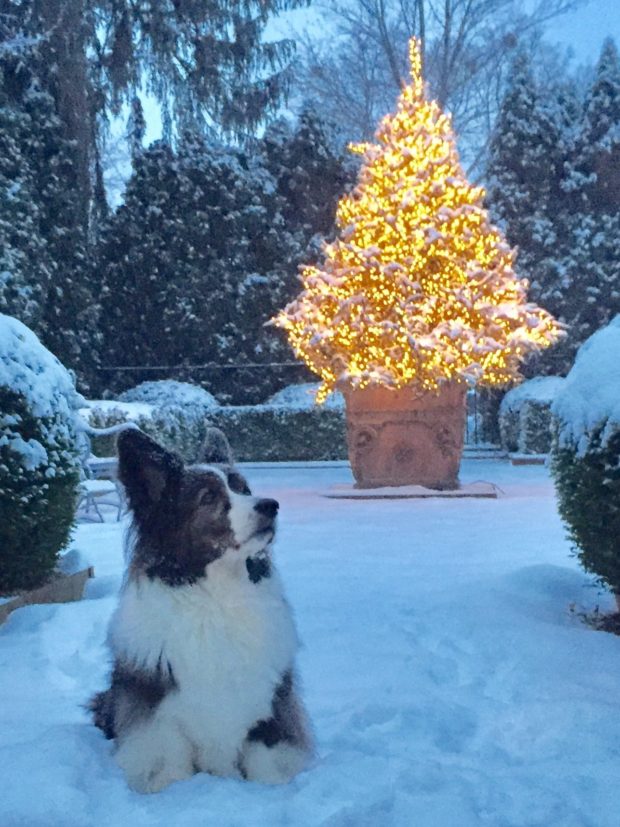 Milo kept me out until just after dark.
Milo kept me out until just after dark.
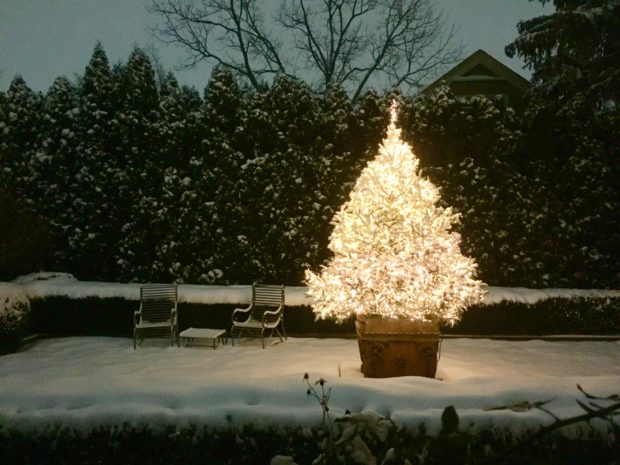 That lighted tree from inside? A brightly shining Christmas moment. A landscape and garden moment. The view out the window was a happy view indeed.
That lighted tree from inside? A brightly shining Christmas moment. A landscape and garden moment. The view out the window was a happy view indeed.
 Later, that tree is still shining. Merry Christmas!
Later, that tree is still shining. Merry Christmas!
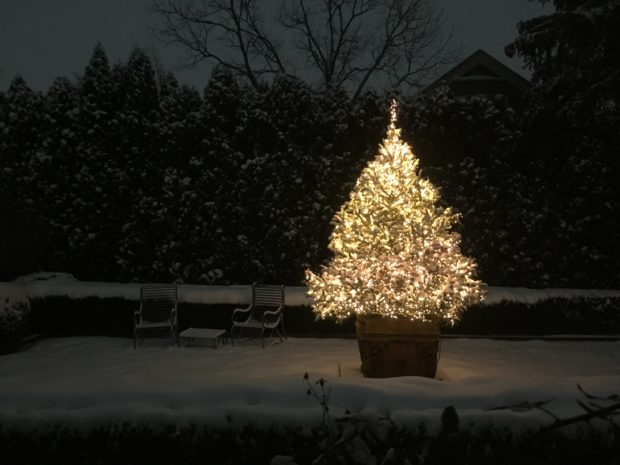 This post was written in honor of, in recognition of, and in special appreciation for my landscape superintendent, Dan Sass. Merry Christmas, Dan.
This post was written in honor of, in recognition of, and in special appreciation for my landscape superintendent, Dan Sass. Merry Christmas, Dan.
Merry Christmas, gardeners all!


